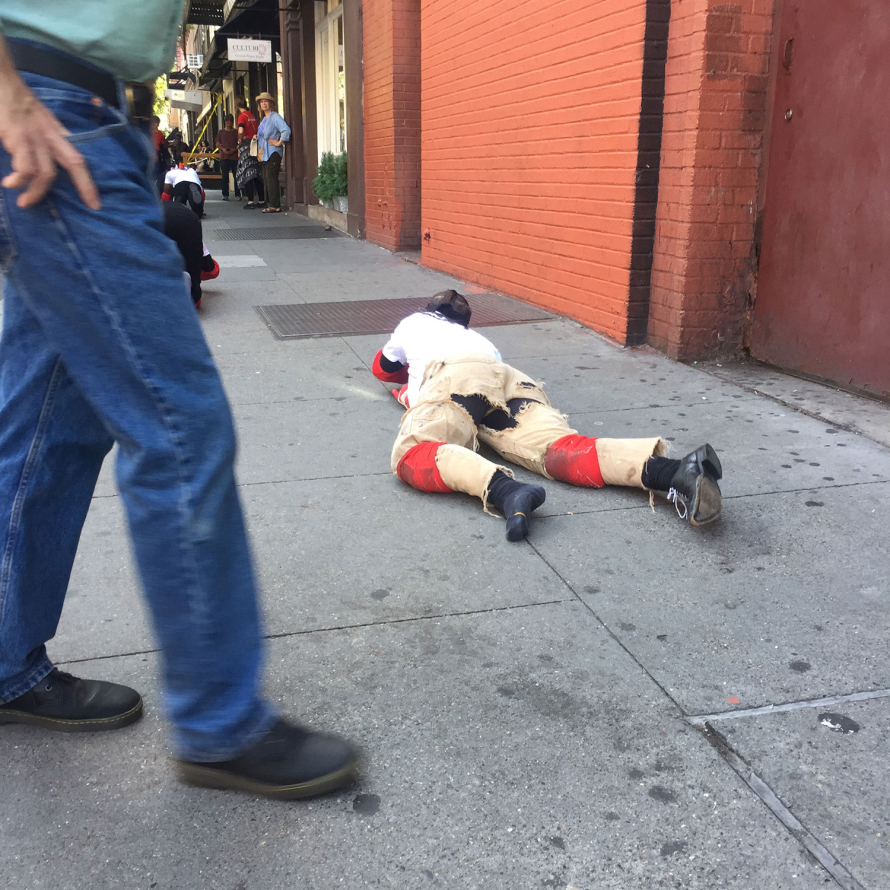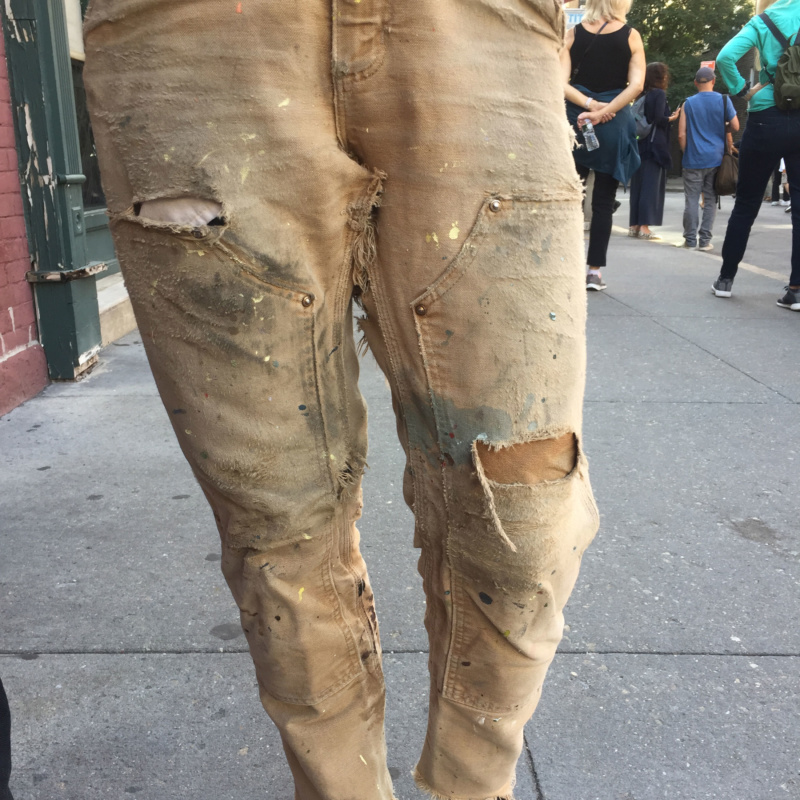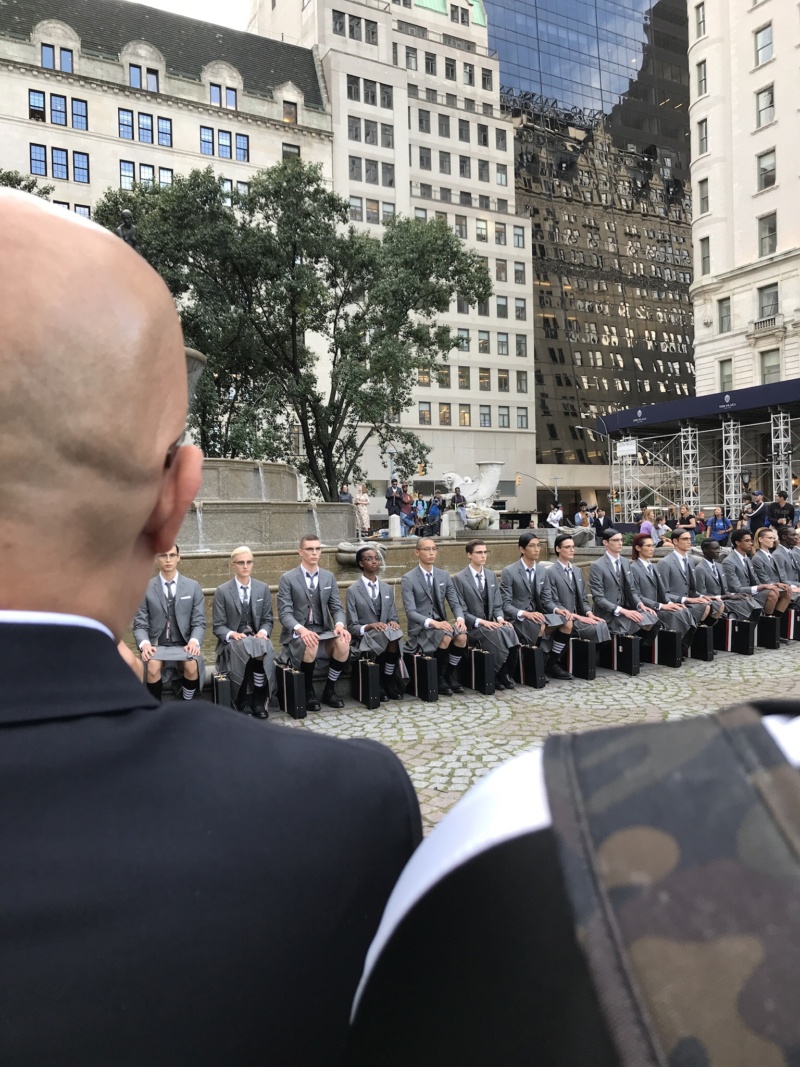
Insistent Horizontality: Conquest, a Pope.L Crawl
It is just after 9AM and the heat is already rising from the blacktop of Corporal John A. Seravalli Playground, at the crux between the West Village and the Meatpacking district. To one side of the basketball courts, a group of people in red t-shirts run around shallow bandstand stages and tents with clipboards, cookies, and color-coded t-shirts splashed with the spectacle’s title. From the outset, Pope.L’s Conquest holds the intra-play between real and mock, carrying connotations of a marathon, because, in fact, it is a marathon of sorts. But the aim, usually so clear, is an open-ended field of questioning, as displayed by the Conquest logo: a ham sandwich fist sprouting out of the N with a wiggly red question mark floating above it all. Many different bodies will be getting down on the crowd and crawling. Sponsored by the Public Art Fund, Conquest is the largest crawl of Pope.L’s to date ever, involving 140 participants(the selection process was by application; crawlers were chosen out of a pool of who-knows-how many; yes, I felt very proud that I was picked; no, we did not get paid.) Conquest coincides with a huge retrospective of Pope.L’s work by way of three separate institutionally organized projects (with Public Art Fund, MoMA and the Whitney) and under the rubric of Instigation, Aspiration, Perspiration.
To kick it all off, Pope.L gets up and speaks indirectly into the microphone a few pithy, convivial sentences about the feeling of embarrassment, but also the fact and luck of choice: “Giving up one’s privilege in order to debase oneself is an act that you don’t have to do.” On that note, he holds a miniature air horn up to the audience; pushing his eyeglasses down, he fumbles with the thing and mutters that he might have broken it, and then, with a little honk, let the games begin!!! A person at the front of the procession holding a broom sets the pace by sweeping the path for the crawlers, occasionally spraying the scent of fresh tobacco from an atomizer as he goes and leading the group towards their own spirited and grueling forward momentum. A trumpet plays a melancholic dirge. Blindfolded, with one shoe off, red elbows- and knees-padded, and flashlight in hand, the first group of five crawlers begins as a steward rolls their spare shoes and backpacks in a red pushcart behind them. Very New York. The group struggles towards the triangle park on Horatio.

The crawl is set up like a relay, with each group of five crawling for a block. In preparation for my own debut on W. 8th St., I peel off to a public restroom; catching up to the crowd proves dramatic. One of the first crawlers is bleeding and another audience member is fighting with a cab driver. As we all walk together, the crowd starts to feel like it is binding into one massive, supportive and vulnerable entity. Almost like circular breathing, over and over the group gets ahead, falls behind, sees one another, smiles or makes eye contact. In the next group, I see someone crawling with a baby strapped to their chest in the shape of a teardrop, their little legs hanging limply—it’s all somehow heart-wrenching. We trundle on. Crawlers come up—out of breath, their white T-shirts awash in dirt, dog piss, and who knows what. Crawling seems to erase all pretense from a body. Now it’s my turn. I notice that if I keep my eyes opened I can see everything through the thin black veil, although the blindfold awkwardly smushes my eyelashes up away from my eyes. I look at the crawlers coming my way and pause. Should I fake that I cannot see? Standing in the sunlight as a white, short, he-she, loco-moting bi-ped with socked toes slightly raised, I wait at attention for the signal to go down. A steward comes and holds my shoulder then guides me across the street through traffic. I hold his lats, keeping my eyes open, but closing them occasionally to feel what it’s like. As soon as we are across the street and go down, it’s like swimming against something that does not give—the hard fact of the ground seems to stretch time out. I do decide to close them.
I take the rear of my group. I’m flapping my legs behind me and doing a messy military crawl with my forearms. My legs feel almost excessive and in order to keep them in check I try to find a circular motion—but the goddamn ground is in the way. I’ve got my stroke and it’s energetically inefficient, but form does feel important to me, something which I will give up pace for. The ground is absolutely unwieldy. Through un-nameable wet spots and over metal grates, horizontal movement comes with no thanks to anyone else but your own will. Once adjusted to this new reality, I feel the hard-ass Sadist coach inside my head pipe up as my soft lump of flesh bends and surrenders to the cement. “Or you can give up.” “Fuck you!” I hiss back at the voice in my mind. An elbow pad comes off but the show must go on! The motor-boating picks up pace. “Great job,” I hear my steward say. “Fuck off,” I think to myself. Don’t mollycoddle me, don’t cheer me on—and then something a bit harsher pops into my head: “Stop making this a tourist act.” In that moment there is nothing but me and the ground—this is a solo act shrouded in collectivity and bonhomie.
I hear a beautiful song floating down the sidewalk from a passerby’s nearby speakers: the era of Luther Vandross but I don’t know it. I feel my body loosen as it passes. It feels like a shower. I crawl slowly forward. A steward helps me up and I have the impulse not to take his hand. I get up, pull my blindfold off, and here is this good-willing person with an open face, smiling at me. I feel a change in myself, certain now that everyone’s shift is a wholly personal experience. My elbow is bleeding and my pants are ripped. That was just a block, being mollycoddled all the way! Think: forty years of this! Forty performances! The scope of Pope.L’s crawls seems to expand in front of me. As I am leaving, I say thank you to the artist. I feel shy, tongue-tied, and sure that he must be tired, but I blurt out something along the lines of, “Crossing the street crawling! Wow. So different to do it on your own!” He smiles and acknowledges the difference.

Insistent Verticality: Thom Browne’s The Office People
It is September 7th at 5 in the afternoon in New York City: i.e., temperature-wise, it is hardly bearable to wear any kind of structured clothing yet. A group has gathered at the corner of 5th Avenue and 58th St., right below The Plaza and fountain. People talk in discrete groups of two or three, though there are a few individuals holding court: someone looking like Radclyffe Hall with a horse-hair hat, shorts, lots of action on the ankles, and a button that says “Lesbians against Trump”; another, a sophisticate with tattoos all over their face and a chunky red corduroy shorts-and-blazer suit, standing near the window of Bergdorf’s and letting their picture be snapped as a tourist asks, “What’s happening? Are you guys waiting for the Kardashians to come out?” Two dapper dans with different toned gold brogues come together as if they have magnets on the end of their toes and snap each other’s picture. It’s a pretty firm confirmation of no, no, these people are not waiting for the Kardashians.
So, what’s happening? A fashion Happening, and much like a fashion show it seems the anticipation is building into its own event. Just as the group seems to have reached its ultimate zenith and must be about to disperse, suddenly, in perfect step with one another, a group of twenty or so models sharply cut around the corner, signature Thom Browne kilt tails flaring as they turn to stop in a neat line. One hand holding a briefcase and the other falling straight at their sides, they stare obstinately at the crowd through horn-rimmed glasses. Half tableaux-vivants, half pulsing advertisement, they stand in the shade of the Bergdorf Goodman store, the automatic rotating doors ever-sweeping behind them, until their closeness and stillness allows for your eyes to scan, trace, and transfer the visuals to sensations into your own body: the texture of tightly woven grey suiting; the tightness of the dark, high socks; the crispness of the cotton button-ups; the hang of the grey cardigan with striped grosgrain ribbon plackets; the perfection of two buttons buttoned. Life moves around them. Cars honk and echo through the warm air and down the avenues. The Office People: there is a twinge of irony in the title—a roving and wistful nostalgia for structure. The outfit is like a well-made bed. Everything lays just so. Nothing is synthetic, scratchy, or itchy. In Thom Browne’s world, you don’t want to leave the structure because the structure holds you in all the right places. It is the kink of Modernism: freedom through conformity. Unlike the street actions of Pope.L, this is about High Verticality. No re-inventing of the wheel here; rather, Browne pays attention to every detail the wheel could offer and, in this day, such a sentiment is both political and perverse.
“There go the clones,” someone says. Off they go at a fast clip, a human caterpillar crossing the street while a man with a camera in a floating harness rigorously keeps the pace. The rest of the crowd gets the message and saunters towards The Plaza. The improv and heat of the city take our bodies back over. Tourists, the well-to-do, and homeless people sit around the slow trickle of the fountain. A group of Thom Browne “plants” look like they are waiting for the horses to come in at the Epsom Derby. And here they come now, in two rows like an illustration from Bemelmans’s Madeline, marching in blissful surrender. I think of nuns in step, Maoists in the hey-day and hope of the Revolution, Britain on the Dole, Tati’s Playtime, and the Takarazuka Revue. A whistle sounds and the group of seemingly random people at the fountain disperse: Poof! The Office People come to take their places and in pedestrian unison they sit and remove from each briefcase a plain triangle of a sandwich wrapped in wax paper. They eat their sandwiches soberly until the whistle blows again, a signal to pull out hardcover books and begin to read. So obedient!
In Thom Browne’s world you start this kind of surrender young and let it hold your calves for the rest of your life…The Office People…you give the structure something and it gives back to you…what a world! Watching the model’s eyes zigzag back and forth over the pages, it does feel appropriate to be on the outside looking in on such a fantasy world. In Pope.L’s crawl, spectators kneel down to urge the crawlers on and snap pictures on their devices with a long and low sidewalk perspective. With The Office People, moments with the models are always framed in front of something else that gives appropriate context: Bergdorf, the fountain. Despite us all being in the rhythms and chaos of the streets of New York, Thom Browne has managed to control exactly how he wants his audience to see the performance. It is wholly about viewership, not a shred of collective participation implied.
There comes a sound from behind us, facing the team—the bleating of a horn instrument. Is this where inserted fantasy gets finally run over by the reality of our collective predicament? The answer is no. The crowd parts for a model playing a trombone. He sallies back and forth, then throws his instrument muter in the fountain. The group gets up, nonplussed, and with one more whistle blow they are gone, marching back to where they came from. On the sidelines of the crowd, Thom Browne himself stands in his signature grey short suit and no socks, and a tourist runs up to ask to take his picture with him. The designer obliges with decorum, then calls for a Thom Browne-suited person to accompany him up to the release of his Women’s collection at, of course, Bergdorf Goodman. The crowd starts to move and reality starts chugging in like a steam train, suddenly ramping up to its normal technolust speed. A sense of awe for the city overwhelms me. It’s amazing to be out in the city participating as a body with other bodies, ever-changing orientation and perspective, weaving in and out of one’s own reality and into those of others.




